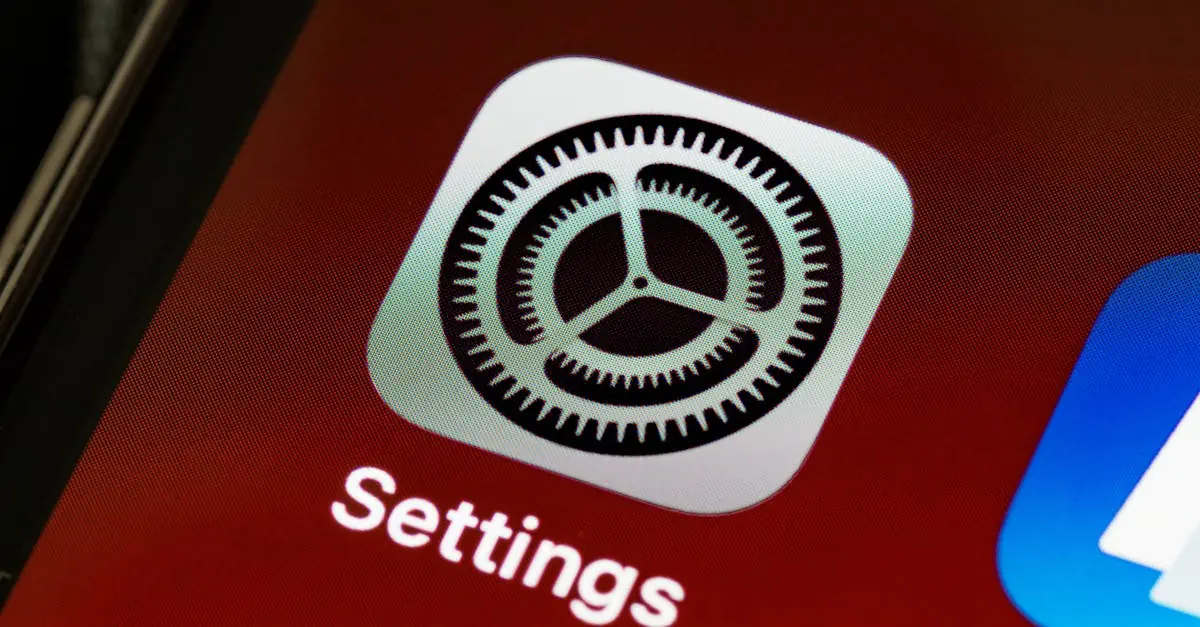Table of Contents
ToggleFinding iOS settings on an iPhone can feel like searching for a needle in a haystack—if the haystack were made of apps and the needle was a crucial feature you desperately need. But don’t worry; it’s not a secret society. The settings menu is just a tap away, waiting to unlock a treasure trove of customization options and essential features.
Understanding iOS Settings
Locating iOS settings on an iPhone serves as an essential task for users looking to customize their devices. The settings menu provides access to various features and personalization options.
Importance of iOS Settings
iOS settings enable users to optimize their experience on an iPhone. Configuration options let individuals manage notifications, privacy, and accessibility features. Customizing these settings improves usability for different needs. Security measures including passcodes and biometrics offer added protection for personal data. Regular updates ensure that users can access the latest features through this menu. Awareness of these settings enhances overall device functionality, making the phone more user-friendly.
Common Features in iOS Settings
iOS settings cover a wide range of features. The Notifications section helps users control alerts from apps and adjust sound preferences. The Display & Brightness menu influences screen readability and battery conservation. In the Privacy section, users can manage app permissions and safeguard personal information. Additionally, the Sounds & Haptics settings allow customization of ringtones and vibrations. Each feature contributes to a smoother and more tailored iPhone experience, enhancing user satisfaction.
Locating iOS Settings on iPhone
Finding the Settings app on an iPhone is straightforward. Users can access it through a dedicated app icon located on the Home screen.
Accessing the Settings App
The Settings app features a gear icon, easily identifiable among other applications. Tapping this icon opens a menu filled with customization options. Users can manage notifications, adjust display settings, and alter privacy controls from this central hub. For those who can’t find it, swiping down on the Home screen brings up the search bar, allowing for quick searches for “Settings.” This search function simplifies navigation, ensuring users access their desired features without hassle.
Using Siri to Find Settings
Siri offers a hands-free method for locating the Settings app. Users can simply activate Siri by saying, “Hey Siri,” or pressing the side button. Commands like “Open Settings” prompt Siri to launch the app instantly. This feature works effectively, saving time when navigating the iPhone. Voice commands provide an effortless way for users to customize their devices, ensuring they access settings promptly. Overall, utilizing Siri enhances user experience, combining convenience with efficiency.
Navigating iOS Settings Menu
Finding the iOS settings menu simplifies device customization. The Settings app provides numerous features to enhance the iPhone experience.
Key Sections of the Settings App
The main sections within the Settings app include Notifications, Display & Brightness, Privacy, and Sounds & Haptics. Users manage notifications by modifying alert styles and setting preferences for individual apps. Display & Brightness allows adjustments to brightness levels and Night Shift settings. Within Privacy, users control app permissions and location services, ensuring data security. Sounds & Haptics offers options to customize ringtones, notification tones, and vibration patterns for specific alerts.
Customizing Settings for Optimal Use
Personalizing settings boosts functionality and user experience. Individuals can adjust screen time limits to promote healthier device use while exploring Focus modes to minimize distractions. Assigning unique ringtones for contacts ensures efficient communication. Enabling features such as Night Shift adjusts blue light exposure, promoting better sleep quality. With regular updates, Apple introduces improved settings that enhance user control, ensuring each iPhone meets individual needs effectively.
Tips for Troubleshooting iOS Settings
Locating and adjusting iOS settings can sometimes present challenges. However, navigating common issues remains straightforward with a few targeted solutions.
Common Issues and Solutions
Users often face difficulties adjusting notification preferences. To resolve this, check the Notifications section for individual app settings. Display and brightness inconsistencies might occur; adjusting brightness levels can help. Privacy settings might not align with user needs, so reviewing permissions for individual apps is crucial. Another frequent problem involves apps misbehaving. Restarting the iPhone can often rectify such glitches. Additionally, ensuring the device has the latest updates can address many issues, as Apple routinely releases fixes that enhance functionality and security.
Resetting Settings if Necessary
Resetting settings can restore an iPhone to its original configuration without deleting personal data. Navigate to Settings, then choose General, followed by Transfer or Reset iPhone. From there, select Reset, and choose Reset All Settings for a complete reset. This action clears customized settings while retaining apps and data. It’s essential to remember that users will need to reconfigure preferences for Wi-Fi networks and passwords after performing this action. Doing this often resolves persistent problems and offers a fresh start for troubleshooting.
Finding the iOS settings on an iPhone doesn’t have to be a daunting task. With the Settings app easily accessible on the Home screen and the option to use Siri for voice commands, users can quickly navigate to the features they need. Personalizing the device through various settings enhances the overall experience and ensures that each iPhone meets individual preferences and requirements.
By understanding how to manage notifications, privacy settings, and display options, users can make the most of their devices. Regular updates from Apple further improve functionality and security, allowing for a seamless user experience. Embracing these settings empowers users to tailor their iPhones to better suit their lifestyles.




